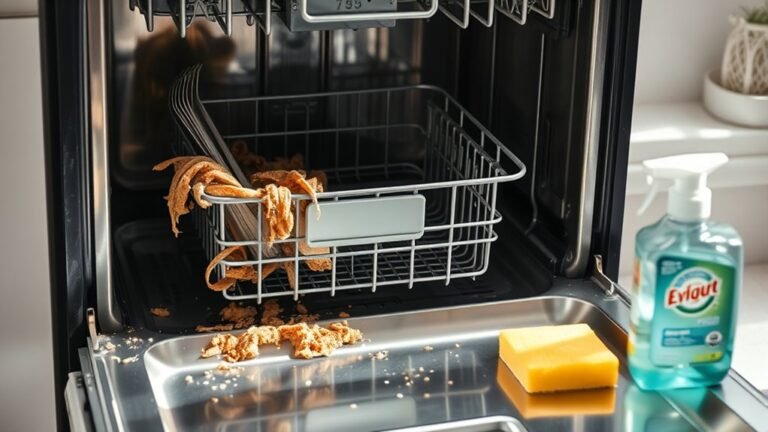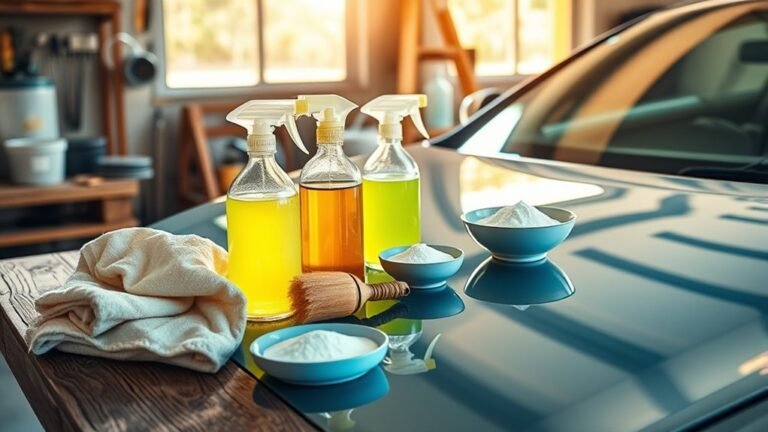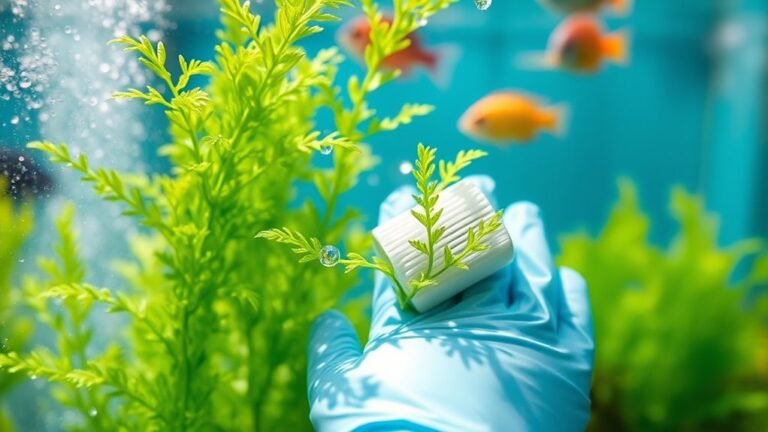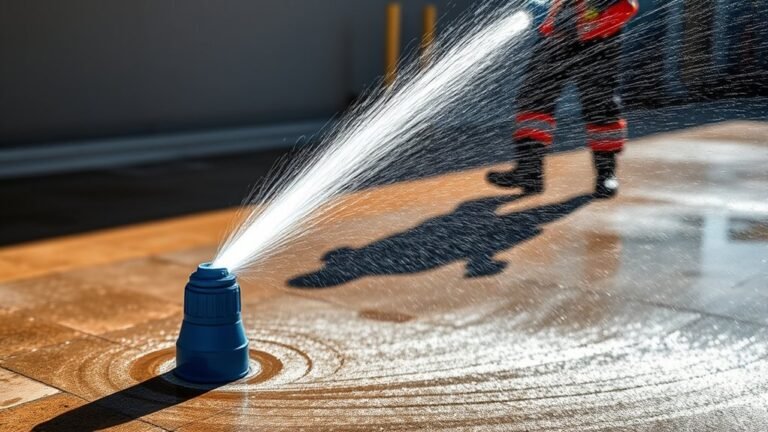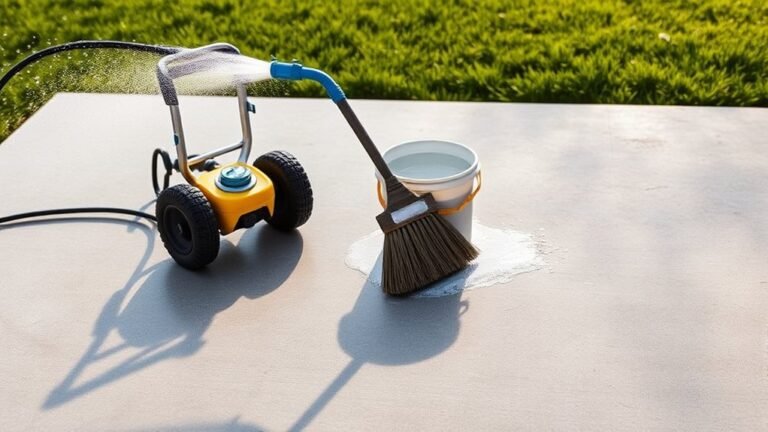Mistakes to Avoid When Cleaning Your Car
Avoid using dish soap instead of car shampoo, as it strips protective wax and promotes paint dulling. Don’t wash your car under direct sunlight to prevent water spots and streaking. Always use the two-bucket method to avoid reapplying dirt, and clean wheels properly to remove corrosive brake dust. Avoid rough or dirty towels that cause micro-scratches, and never wax or polish a dirty surface. Neglecting interior and undercarriage care leads to damage too. Keep exploring for a thorough guide on preserving your car’s finish and value.
Using Dish Soap Instead of Car Shampoo

Using dish soap instead of car shampoo might seem like a convenient shortcut, but it can cause significant damage to your vehicle’s paint and protective coatings. Dish soap is formulated to cut through grease and food residues, which means it strips away the wax and sealants designed to protect your car’s surface. Unlike car shampoo, which contains pH-balanced and paint-safe detergents, dish soap is harsh and can accelerate oxidation, leading to dullness and premature paint degradation. If you want to maintain your vehicle’s finish and preserve that feeling of freedom on the road, it’s essential to use a proper car shampoo. These specialized products clean effectively without compromising protective layers, ensuring your car stays vibrant and shielded from environmental elements.
Washing Your Car Under Direct Sunlight
Washing your car under direct sunlight causes water to evaporate quickly, leading to water spots that can etch the paint surface. You’ll also notice that soap dries too fast, reducing its ability to break down dirt effectively. To prevent these issues, it’s best to clean your car in a shaded area or during cooler parts of the day.
Water Spots Formation
Although it might seem convenient to clean your car in direct sunlight, doing so considerably increases the risk of water spots forming on the paint. When the sun heats the surface, water droplets dry rapidly, leaving behind mineral deposits that etch into the clear coat. To guarantee effective drying and water spot prevention, avoid washing your car during peak sunlight hours. Instead, choose shaded areas where water evaporates slowly, allowing you to wipe the surface before minerals settle. Use microfiber towels for thorough drying, as they absorb moisture efficiently without scratching. Paying attention to these factors preserves your car’s finish, granting you the freedom to maintain a flawless appearance without the frustration of stubborn water spots compromising your effort.
Soap Drying Too Fast
Direct sunlight not only accelerates water evaporation but also causes soap to dry too quickly on your car’s surface. When soap dries rapidly, it leaves behind residues, streaks, and potential water spots, compromising your car’s finish. Different soap types react variably under these drying conditions; for example, pH-neutral soaps tend to rinse off cleaner, reducing the risk of residue compared to harsher detergents. To maintain control and freedom over your cleaning process, avoid washing your car under direct sunlight. Instead, choose shaded areas or cooler times of day to optimize drying conditions. This approach guarantees soap remains workable longer, allowing you to rinse thoroughly and prevent unwanted marks. Managing drying speed is essential for a spotless, damage-free finish.
Using a Single Bucket for Washing and Rinsing

If you use a single bucket for both washing and rinsing, you risk transferring dirt and debris back onto your car’s surface, which can cause scratches and swirl marks. To maintain peak cleaning efficiency, always practice bucket separation by using one bucket filled with soapy water and another with clean rinse water. This method prevents contaminants from reattaching to your wash mitt, preserving its effectiveness and safeguarding your paint. Incorporating a grit guard at the bottom of each bucket further enhances debris removal, minimizing the potential for abrasive particles to cause damage. By adhering to this technique, you not only improve cleaning results but also extend the longevity of your vehicle’s finish. Prioritize bucket separation to achieve a meticulous, scratch-free wash every time.
Ignoring the Wheels and Tires
You shouldn’t overlook your wheels and tires when cleaning, as brake dust can accumulate and cause corrosion if left untreated. It’s important to use specialized cleaners designed for wheels to avoid damaging finishes or rubber components. Avoid harsh chemicals that can degrade tire rubber and wheel coatings, ensuring both safety and appearance are maintained.
Neglecting Brake Dust
Although brake dust might seem like a minor detail, neglecting to clean your wheels and tires can lead to corrosion and decreased performance over time. Brake dust contains abrasive particles and metallic compounds that, if left unattended, damage the wheel’s finish and accelerate rust formation. You’ve got to adopt effective cleaning techniques—use a dedicated wheel cleaner formulated to dissolve brake dust without harming surfaces. Apply it generously, allowing it to break down contaminants before scrubbing with a soft brush to reach tight spots. Rinse thoroughly with water to prevent residue buildup. Regular brake dust removal not only preserves your wheels’ aesthetic but also maintains peak brake function by minimizing particulate accumulation. Keeping your wheels clean supports both your vehicle’s performance and your freedom to drive worry-free.
Using Harsh Chemicals
Brake dust removal demands careful product selection, as harsh chemicals can quickly undermine your cleaning efforts, especially on wheels and tires. Using aggressive solvents or acidic cleaners might strip protective coatings, causing premature corrosion or fading. Instead, you should opt for chemical alternatives designed to break down grime without damaging surfaces. Eco friendly cleaners often combine biodegradable ingredients that effectively lift brake dust while preserving wheel integrity. They also reduce environmental impact, aligning with your freedom to maintain your car responsibly. Avoid products containing ammonia, bleach, or phosphate, as these can degrade rubber and paint on tires and rims. By choosing safer, targeted formulations, you guarantee thorough cleaning without compromising the longevity or appearance of your wheels and tires. This approach protects your investment and supports sustainable car care practices.
Using Dirty or Rough Towels for Drying

Using dirty or rough towels for drying your car can cause micro-scratches and swirl marks on the paint surface. Selecting the right towel material and applying a proper drying technique are essential for protecting your car’s finish. Avoid using towels that trap dirt or have abrasive fibers, as they can damage the clear coat.
| Towel Material | Drying Technique |
|---|---|
| Microfiber (soft) | Pat dry, don’t rub harshly |
| Cotton (rough) | Avoid, causes scratches |
| Chamois (gentle) | Squeeze water, don’t drag |
Skipping the Pre-Wash Rinse
You shouldn’t skip the pre-wash rinse because it removes loose dirt and debris from your car’s surface. If you don’t rinse first, those particles can cause paint scratches during washing. A thorough rinse minimizes abrasion and preserves your car’s finish.
Remove Loose Dirt
Although it might seem tempting to dive straight into scrubbing, skipping the pre-wash rinse can embed loose dirt and debris deeper into your car’s paintwork, increasing the risk of scratches and swirl marks. Proper debris removal is crucial for effective surface preparation. To remove loose dirt without causing damage:
- Use a gentle water spray to loosen and wash away surface dust and particles.
- Focus on areas prone to trapping debris, such as wheel wells and lower panels.
- Avoid high-pressure settings that can force dirt into crevices or chip paint.
- Inspect the surface visually to verify all loose contaminants are removed before washing.
Following these steps guarantees a clean surface, reducing abrasive contact during washing and preserving your car’s finish.
Prevent Paint Scratches
One critical step many skip is the pre-wash rinse, which plays a key role in preventing paint scratches. By thoroughly rinsing your car before applying soap, you remove abrasive particles like dirt and grit that can cause micro-scratches when rubbed against the paint. Skipping this step risks embedding contaminants beneath your wash mitt or microfiber towels, compromising protective coatings and the paint’s integrity. To maintain your vehicle’s finish, always start with a high-pressure rinse, loosening debris without friction. Then, use clean microfiber towels designed for automotive care to gently dry the surface, minimizing swirl marks. This method preserves your car’s protective coatings, ensuring a smooth, scratch-free finish while giving you the freedom to enjoy a flawless, polished appearance every time you clean.
Applying Wax or Polish on a Dirty Surface
Before applying wax or polish, verify the car’s surface is thoroughly clean and dry; any dirt or debris left behind can cause scratches and reduce the effectiveness of the protective coating. Proper surface preparation is essential to successful waxing techniques. Here’s what you need to do:
Ensure your car’s surface is spotless and dry before waxing to prevent scratches and enhance protection.
- Wash the vehicle with a pH-balanced car shampoo to remove contaminants.
- Dry the surface completely using a microfiber towel to avoid water spots.
- Inspect for any remaining dirt or grime, especially in crevices.
- If necessary, use a clay bar to eliminate embedded particles.
Skipping these steps compromises the wax or polish’s ability to bond, leading to uneven protection and potential paint damage. Always prioritize meticulous surface preparation to maximize the durability and shine of your car’s finish.
Using Household Glass Cleaners on Windows
Once you’ve guaranteed your car’s paintwork is properly prepared and protected, the next area to address is the windows. Avoid using standard household glass cleaners on your car’s windows, as many contain ammonia or harsh chemicals that can damage tint films and rubber seals. Instead, opt for specialized automotive glass cleaner alternatives designed to protect your vehicle’s surfaces while providing streak-free clarity. Employ window cleaning techniques that involve microfiber cloths and gentle, circular motions to minimize scratches and residue. Additionally, avoid cleaning windows under direct sunlight to prevent rapid drying and streaks. By selecting proper products and applying precise techniques, you maintain ideal visibility and preserve your car’s aesthetic integrity, granting you the freedom to drive safely and confidently without compromising your vehicle’s condition.
Neglecting the Interior Cleaning
Although exterior care often takes priority, neglecting your car’s interior cleaning can lead to long-term damage and decreased comfort. Regular interior vacuuming and upholstery cleaning are essential to maintain hygiene and preserve materials. Here’s what you need to focus on:
Neglecting interior cleaning risks damage and discomfort; regular vacuuming and upholstery care preserve hygiene and materials.
- Interior Vacuuming: Remove dirt and debris from carpets and seats to prevent abrasion and wear.
- Upholstery Cleaning: Use appropriate cleaners for fabric or leather to avoid deterioration and staining.
- Dashboard and Console Care: Clean these areas with non-abrasive products to prevent cracking.
- Air Vent Maintenance: Clear dust buildup to improve air quality and system efficiency.
Skipping these steps reduces your vehicle’s value and compromises your driving experience. Stay diligent to enjoy a clean, comfortable interior that reflects your freedom.
Overlooking the Undercarriage and Wheel Wells
If you skip cleaning the undercarriage and wheel wells, you’ll expose critical components to corrosion, dirt buildup, and premature wear. Undercarriage maintenance is vital because debris, salt, and grime accumulate in these hard-to-reach areas, accelerating rust formation on the frame, exhaust, and suspension parts. Wheel wells trap mud and road contaminants, which can degrade protective coatings and cause metal fatigue. Regularly rinsing with a high-pressure hose and using a dedicated brush guarantees thorough removal of corrosive materials. Don’t neglect these zones; failure to maintain them compromises your vehicle’s longevity and performance. By integrating undercarriage and wheel wells cleaning into your routine, you preserve structural integrity and maintain freedom on the road without unexpected breakdowns or costly repairs.
Frequently Asked Questions
How Often Should I Wash My Car to Maintain Its Paint?
Did you know that environmental contaminants can reduce your car’s paint lifespan by up to 30%? To maintain ideal paint protection, follow frequency guidelines recommending washing your car every two weeks. This schedule removes harmful debris and pollutants without over-washing, which can strip wax layers. If you drive in harsh conditions, increase washing frequency to weekly. Sticking to these precise intervals helps preserve your car’s finish, giving you the freedom to enjoy a vibrant, protected ride.
What Is the Best Time of Day for Car Cleaning?
The best time for car cleaning is during morning cleaning or evening maintenance when temperatures are cooler. This prevents water spots and soap from drying too quickly, which can damage your paint. Early morning offers dew that helps loosen dirt, while evening maintenance allows contaminants to settle. Avoid midday sun to protect your finish and enjoy more effective, streak-free results, giving you freedom to keep your car looking pristine with less effort.
Can I Use Microfiber Cloths for Both Washing and Drying?
Think of microfiber cloths like a multitool in your cleaning kit—they’re designed for precision and efficiency. You can use microfiber cloths for both washing and drying because their dense fibers trap dirt and absorb water effectively. However, using separate cloths for each task prevents cross-contamination and preserves their Microfiber benefits. Choosing the right cloth types for washing and drying guarantees you maintain your car’s finish while enjoying the freedom of a spotless ride.
How Do I Safely Clean Leather Seats?
To safely clean leather seats, start by vacuuming to remove loose dirt without scratching. Use a pH-balanced leather cleaner with gentle seat cleaning techniques—apply it with a soft cloth in circular motions. After cleaning, let the leather dry completely before leather conditioner application. This step nourishes the leather, preventing cracks and maintaining flexibility. Avoid harsh chemicals, and always test products on a hidden area first to guarantee colorfastness and material safety.
Is It Necessary to Clean the Engine Bay Regularly?
Cleaning your engine bay is like giving your car’s heart a fresh breath—engine cleaning benefits include improved performance and early detection of leaks or corrosion. Regular engine bay maintenance prevents grime buildup that can cause overheating or electrical issues. While not always mandatory, keeping it clean extends your vehicle’s lifespan and guarantees reliability. Just be cautious with sensitive components and use proper techniques to avoid damage, preserving your freedom on the road.

